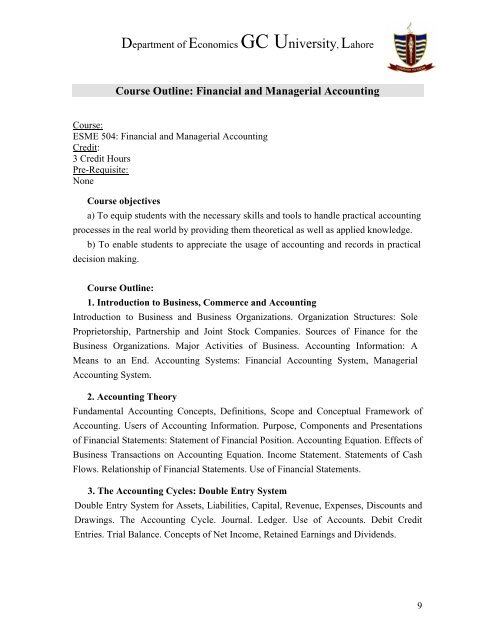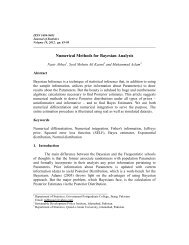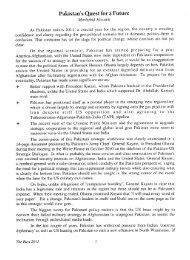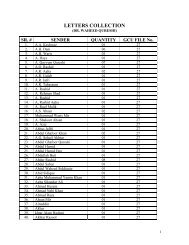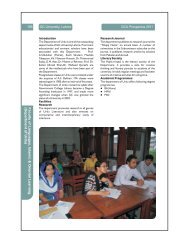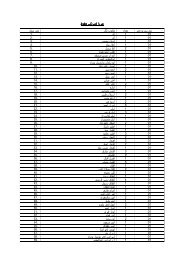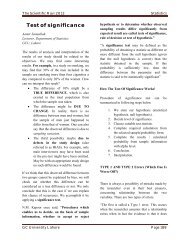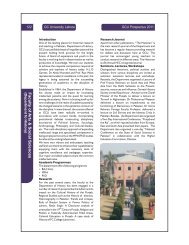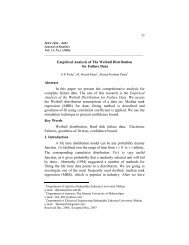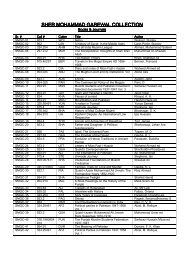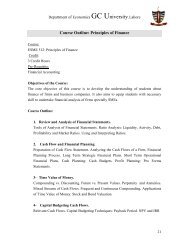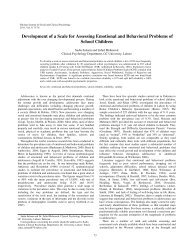Course Outline: Financial and Managerial Accounting - Government ...
Course Outline: Financial and Managerial Accounting - Government ...
Course Outline: Financial and Managerial Accounting - Government ...
Create successful ePaper yourself
Turn your PDF publications into a flip-book with our unique Google optimized e-Paper software.
Department of Economics GC University, Lahore<br />
<strong>Course</strong> <strong>Outline</strong>: <strong>Financial</strong> <strong>and</strong> <strong>Managerial</strong> <strong>Accounting</strong><br />
<strong>Course</strong>:<br />
ESME 504: <strong>Financial</strong> <strong>and</strong> <strong>Managerial</strong> <strong>Accounting</strong><br />
Credit:<br />
3 Credit Hours<br />
Pre-Requisite:<br />
None<br />
<strong>Course</strong> objectives<br />
a) To equip students with the necessary skills <strong>and</strong> tools to h<strong>and</strong>le practical accounting<br />
processes in the real world by providing them theoretical as well as applied knowledge.<br />
b) To enable students to appreciate the usage of accounting <strong>and</strong> records in practical<br />
decision making.<br />
<strong>Course</strong> <strong>Outline</strong>:<br />
1. Introduction to Business, Commerce <strong>and</strong> <strong>Accounting</strong><br />
Introduction to Business <strong>and</strong> Business Organizations. Organization Structures: Sole<br />
Proprietorship, Partnership <strong>and</strong> Joint Stock Companies. Sources of Finance for the<br />
Business Organizations. Major Activities of Business. <strong>Accounting</strong> Information: A<br />
Means to an End. <strong>Accounting</strong> Systems: <strong>Financial</strong> <strong>Accounting</strong> System, <strong>Managerial</strong><br />
<strong>Accounting</strong> System.<br />
2. <strong>Accounting</strong> Theory<br />
Fundamental <strong>Accounting</strong> Concepts, Definitions, Scope <strong>and</strong> Conceptual Framework of<br />
<strong>Accounting</strong>. Users of <strong>Accounting</strong> Information. Purpose, Components <strong>and</strong> Presentations<br />
of <strong>Financial</strong> Statements: Statement of <strong>Financial</strong> Position. <strong>Accounting</strong> Equation. Effects of<br />
Business Transactions on <strong>Accounting</strong> Equation. Income Statement. Statements of Cash<br />
Flows. Relationship of <strong>Financial</strong> Statements. Use of <strong>Financial</strong> Statements.<br />
3. The <strong>Accounting</strong> Cycles: Double Entry System<br />
Double Entry System for Assets, Liabilities, Capital, Revenue, Expenses, Discounts <strong>and</strong><br />
Drawings. The <strong>Accounting</strong> Cycle. Journal. Ledger. Use of Accounts. Debit Credit<br />
Entries. Trial Balance. Concepts of Net Income, Retained Earnings <strong>and</strong> Dividends.<br />
9
Department of Economics GC University, Lahore<br />
4. Books of Original Entry<br />
Sales Journal <strong>and</strong> Ledger, Purchase Journal <strong>and</strong> Ledger, Return Journals. Cash Books.<br />
Petty Cash Books. General Journals.<br />
5. The <strong>Accounting</strong> Cycle: Adjustments before Final Accounts<br />
Adjusting Entries: Conversions of Assets to Expenses. Conversion of Liabilities to<br />
Revenues. Accrued Expenses <strong>and</strong> Revenues. Adjusting Entries <strong>and</strong> <strong>Accounting</strong><br />
Principles. Effects of Adjusting Entries. Use of Worksheet.<br />
6. The <strong>Accounting</strong> Cycles: Reporting <strong>Financial</strong> Results.<br />
Preparing <strong>Financial</strong> Statements. Relationship among the <strong>Financial</strong> Statements. Closing<br />
the Temporary Equity <strong>Accounting</strong>. After Closing Trial Balance. Published Accounts.<br />
<strong>Financial</strong> Analysis.<br />
7. <strong>Accounting</strong> for Merch<strong>and</strong>ising Activities<br />
Merch<strong>and</strong>ising Companies, Their Operating Cycle <strong>and</strong> Income Statement. General<br />
Ledger <strong>and</strong> Subsidiary Ledger Accounts. Perpetual <strong>and</strong> Periodic Inventory System.<br />
Modifying an <strong>Accounting</strong> System. Transactions Relating To Purchases <strong>and</strong> Sales.<br />
Evaluating the Performance of Merch<strong>and</strong>ising Company.<br />
8. <strong>Financial</strong> Assets.<br />
Cash Management <strong>and</strong> Bank Reconciliation Statement. Short Term Investments.<br />
<strong>Accounting</strong> for Marketable Securities. Management <strong>and</strong> <strong>Accounting</strong> for Accounts<br />
Receivables. <strong>Accounting</strong> for Notes Receivables <strong>and</strong> Interest Revenues. <strong>Financial</strong><br />
Analysis.<br />
9. Inventories <strong>and</strong> Cost of Goods Sold.<br />
The Flow of Inventory Costs <strong>and</strong> Cost Flow Assumptions: Specific Identification,<br />
Average Costing, FIFO. LIFO Methods <strong>and</strong> Its JIT Inventory Systems. Taking a Physical<br />
Inventory. Treatment of Shrinkage <strong>and</strong> Losses of Inventory. Techniques for Estimating<br />
CGS <strong>and</strong> Ending Inventory. <strong>Financial</strong> Analysis.<br />
10: Plant <strong>and</strong> Intangible Assets.<br />
Major Categories of Plant Assets. Acquisition of Plant Assets. Methods of Deprecation;<br />
Straight Line, Declining Balance Method, the Units of Output Method, Sum of Years'<br />
Digit Method. Disposal of Plant <strong>and</strong> Equipment. Intangible Assets: Amortization;<br />
10
Department of Economics GC University, Lahore<br />
Goodwill, Patents, Trade Marks, Franchises, Copyrights, R&D Costs. Natural Resources.<br />
<strong>Financial</strong> Analysis.<br />
11. Liabilities:<br />
Current Liabilities. Long Term Liabilities. <strong>Accounting</strong> for Notes Payable <strong>and</strong> Bond<br />
Payables. Special Types of Liabilities. Evaluating the Safety of Creditor's Claims.<br />
Estimated Liabilities <strong>and</strong> Loss Contingencies. <strong>Financial</strong> Analysis.<br />
12. Stockholder's Equity: Paid in Capital<br />
Formation of Corporations. Paid-in-Capital of a Corporation. <strong>Accounting</strong> for Issuing<br />
Shares at Face Values, Premium <strong>and</strong> Discount. <strong>Accounting</strong> Purchase <strong>and</strong> Sale of<br />
Treasury Stock. Market vs. Book Value of Stocks. Treasury Stocks. Stock Splits.<br />
<strong>Financial</strong> Analysis.<br />
13 <strong>Financial</strong> Statement Analysis.<br />
Tools of Analysis. Measures of Liquidity <strong>and</strong> Credit Risk: Working Capital, Current<br />
Ratio, Quick Ratio. Debt Ratio, Evaluating <strong>Financial</strong> Ratios. Measures of Profitability:<br />
Classifications in the Income Statement, Earning Per Share, Price-Earning Ratio, Return<br />
On Investment (ROI), Return On Assets (ROA), Return On Equity (ROE).<br />
Recommended Books:<br />
1- <strong>Financial</strong> <strong>and</strong> <strong>Managerial</strong> <strong>Accounting</strong>: The Basis For Business Decisions( Latest<br />
Edition Available) by Williams J.R., Haka S.F., Bettner M.S., Meigs R.F. McGraw-<br />
HilI Irwin.<br />
2- College <strong>Accounting</strong>: A Practical Approach (9th Edition) by Slatter. Prentice Hall<br />
Business Publishing.<br />
3- Business <strong>Accounting</strong> I (15th Edition) by FrankWood <strong>and</strong> Alan Songster.<br />
4- College <strong>Accounting</strong> (1st Edition) by Haddock, Brock, Hahn And Reed.<br />
11


